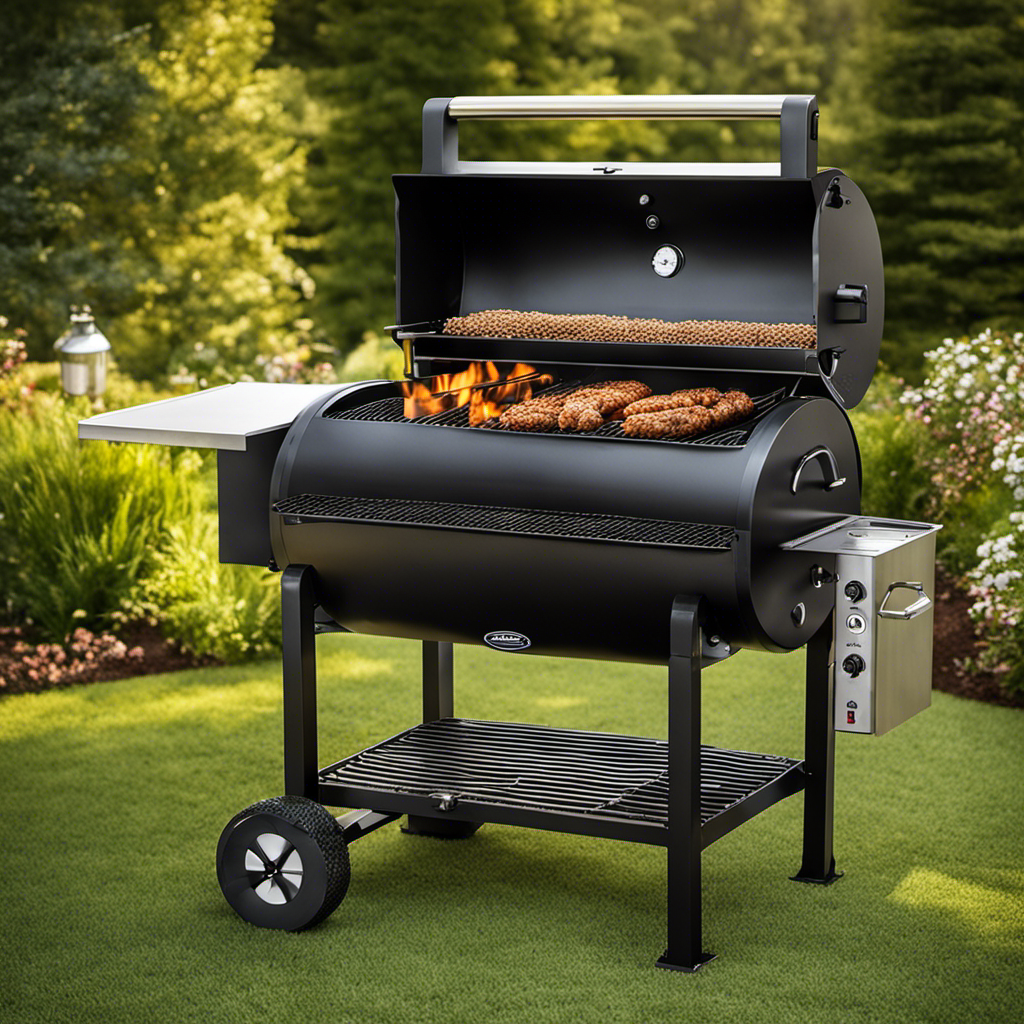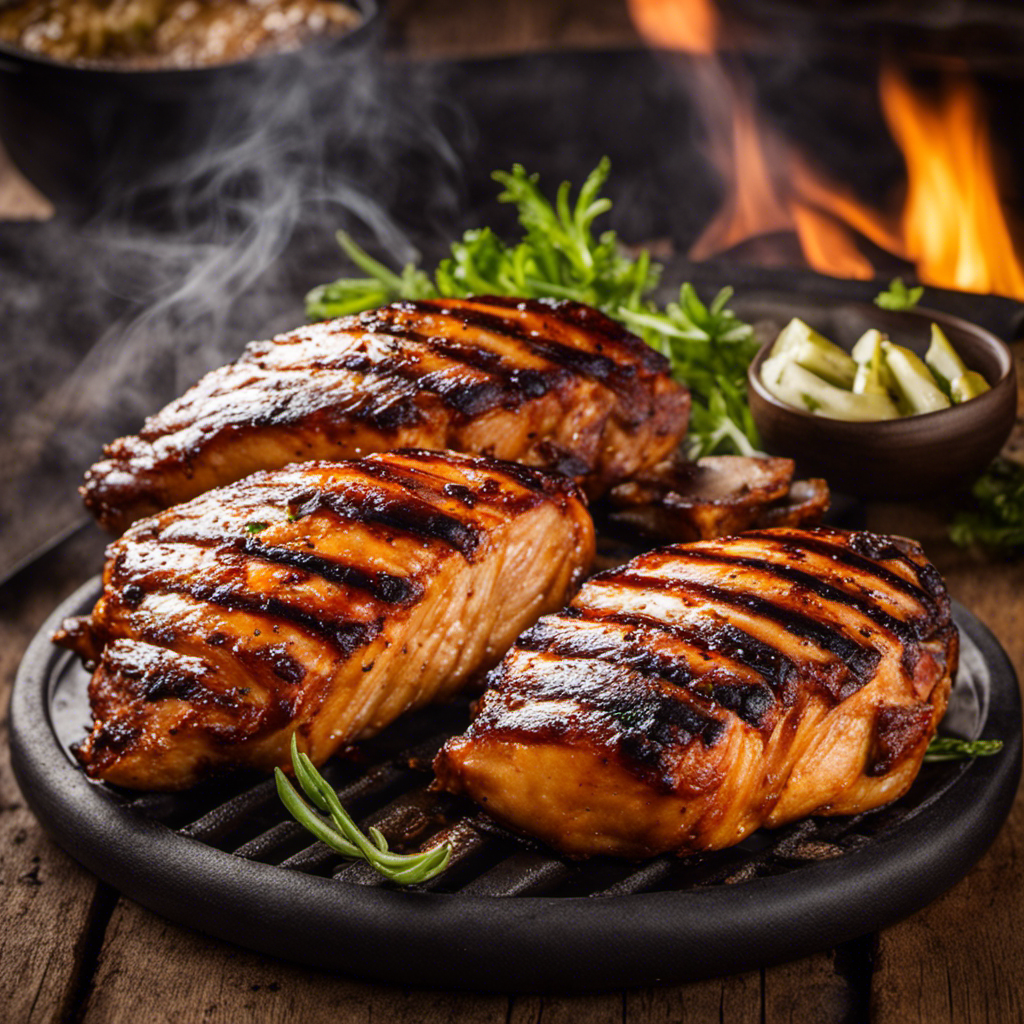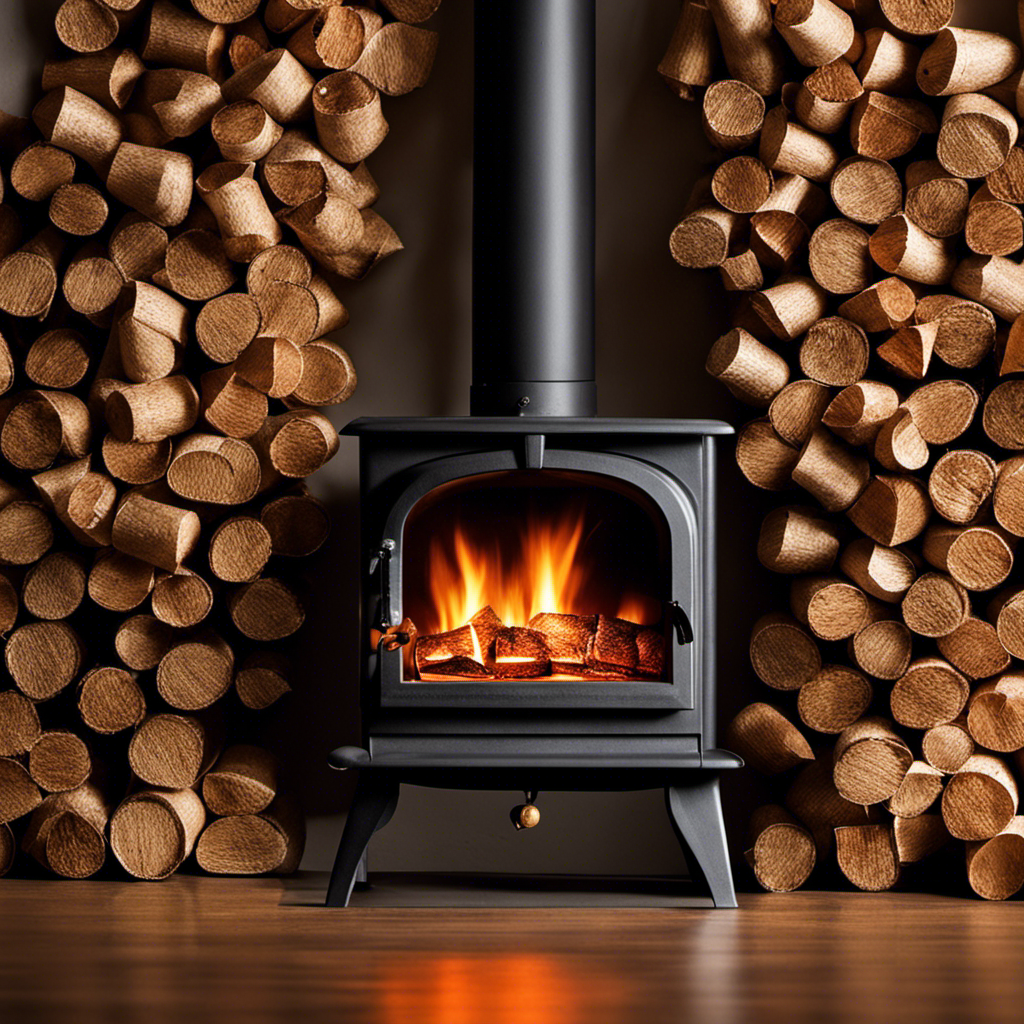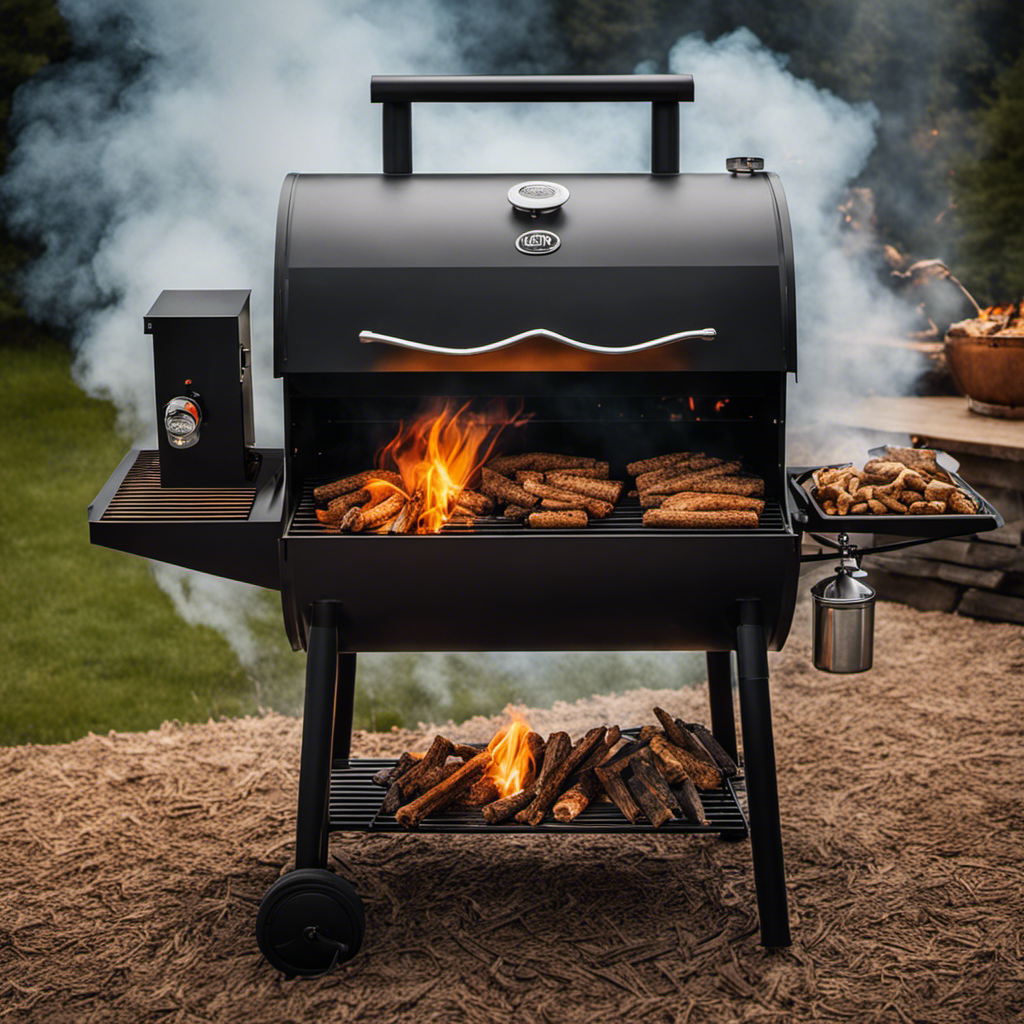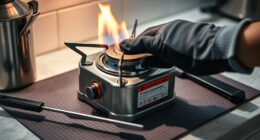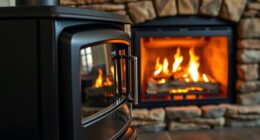As a person with a strong passion for wood pellet stoves, I can vouch for their effectiveness in providing warmth. If you’re unfamiliar with this method of heating, don’t worry! In this article, my goal is to walk you through the fundamental steps of using a wood pellet stove and address common problems you may encounter.
By following these steps, you’ll be able to enjoy the cozy ambiance and cost-saving benefits that come with using a wood pellet stove in no time.
So let’s dive right in!
Key Takeaways
- Wood pellet stoves are highly efficient and cost-effective alternatives to traditional stoves, producing a high amount of heat while using less fuel.
- When choosing wood pellets, opt for brands with low moisture content (below 6%) for efficient combustion and more heat production.
- Proper cleaning and maintenance of the stove, including regular removal of ash and debris, is essential for efficient operation.
- Ensure proper fuel storage by keeping pellets in a dry and well-ventilated area, away from moisture sources, and regularly checking for mold or mildew growth.
Understanding the Basics of a Wood Pellet Stove
Understanding the basics of a wood pellet stove can help you effectively and safely use it in your home. Wood pellet stoves have many benefits, making them a popular choice for heating. They are highly efficient, producing a high amount of heat while using less fuel compared to traditional wood-burning stoves. This not only saves you money but also reduces the environmental impact by minimizing air pollution and carbon emissions.
Wood pellets are made from compressed sawdust or other biomass materials, which means they are a renewable energy source. When choosing the right wood pellets for your stove, it is important to consider factors such as the type of wood used, moisture content, and ash content. By understanding these basics and selecting the appropriate pellets, you can enjoy the full benefits of your wood pellet stove without any hassle.
Choosing the Right Wood Pellets for Your Stove
When selecting the appropriate wood pellets for your stove, it’s crucial to consider factors such as moisture content and pellet durability. These two aspects play a significant role in the overall performance of your wood pellet stove.
Here are some key points to keep in mind when choosing the right wood pellet brand and comparing different wood pellet types:
-
Moisture Content:
-
Opt for pellets with low moisture content, ideally below 6%. This ensures efficient combustion and minimizes creosote buildup.
-
Dry pellets produce more heat, so look for brands that guarantee low moisture levels.
-
Pellet Durability:
-
Choose pellets that are dense and durable, as they will burn longer and provide consistent heat.
-
Check for quality indicators like length consistency, lack of fines (dust), and minimal ash production.
By considering these factors, you can ensure optimal performance from your wood pellet stove.
Now, let’s move on to preparing the stove for use by following a few simple steps…
Preparing the Stove for Use
When it comes to using a wood pellet stove, there are several key points that need to be addressed for proper preparation.
First and foremost is the importance of cleaning and maintenance, which involves regularly removing ash and residue from the stove’s interior and components.
Additionally, proper fuel storage is crucial to ensure the pellets remain dry and free from moisture, as this can affect their performance when burning.
Lastly, ensuring adequate ventilation and following safety guidelines is essential to prevent any potential hazards or accidents while operating the stove.
Cleaning and Maintenance
To keep your wood pellet stove running efficiently, make sure you regularly clean and maintain it. Here are some cleaning techniques and a maintenance schedule to help you with this important task:
-
Clean the burn pot: Remove any ashes or debris from the burn pot using a metal scoop or brush.
-
Check the exhaust vent: Inspect the exhaust vent for any blockages or buildup of creosote. Clear any obstructions to ensure proper ventilation.
-
Clean the glass door: Use a non-abrasive cleaner to wipe away soot and dirt from the glass door, allowing for a clear view of the flames.
-
Inspect and replace gaskets: Check the gaskets around the door and hopper for signs of wear or damage. Replace them if necessary to maintain a tight seal.
Regularly following these cleaning techniques and sticking to a maintenance schedule will ensure that your wood pellet stove continues to operate at its best.
Now let’s move on to proper fuel storage, which is crucial for optimal stove performance.
Proper Fuel Storage
Make sure you store your fuel in a dry and well-ventilated area to maintain its quality. Proper fuel storage is crucial for efficient and safe operation of your wood pellet stove. To ensure organization, designate a specific area for storing your fuel pellets. This could be a corner of your garage or a shed specifically designed for this purpose.
It’s important to keep the pellets away from any moisture sources, such as windows or leaky pipes. Moisture can cause the pellets to degrade and become less effective when burned. Consider investing in waterproof containers or bins to keep the pellets protected from humidity. By controlling moisture levels in your fuel storage area, you will prevent clumping and ensure consistent performance of your wood pellet stove.
When it comes to ventilation and safety, it is essential to have proper airflow around your stored fuel. Good ventilation helps prevent the buildup of gases that could be hazardous when ignited. Ensure there is enough space between the stacked bags of pellets for air circulation. Avoid blocking vents or placing objects on top of the stored fuel that could restrict airflow. Additionally, regularly check for any signs of mold or mildew growth, as these indicate excessive moisture levels which can compromise the quality of your fuel supply.
Transitioning into ventilation and safety considerations without using ‘step’, let’s now discuss how to properly ventilate your wood pellet stove for optimal performance and safety precautions…
Ventilation and Safety
Ensure that your fuel storage area has proper ventilation to prevent the buildup of hazardous gases. Proper ventilation is crucial for maintaining a safe environment when using a wood pellet stove. Regular maintenance of the ventilation system is essential to ensure its effectiveness. Check the vents regularly for any blockages or obstructions, and clean them if necessary.
Additionally, make sure that the air intake vent is clear and unobstructed to allow for proper airflow. Safety precautions should also be taken when operating the stove. Keep flammable materials away from the stove, and never leave it unattended while in use. It’s important to have a fire extinguisher nearby in case of emergencies.
Now, let’s move on to lighting the wood pellets without delay.
Lighting the Wood Pellets
When it comes to lighting wood pellets in a stove, proper pellet ignition is essential for efficient and effective heating.
In this discussion, I will cover key points such as the importance of proper pellet ignition, troubleshooting tips for ignition issues, and how to ensure efficient combustion throughout the burning process.
Proper Pellet Ignition
To properly ignite the wood pellets in your stove, you’ll want to first ensure that the fire pot is clean and free of any debris. This is crucial for an efficient and effective burn. Once you have a clean fire pot, it’s time to consider your pellet fuel options. There are different types of pellets available, such as hardwood or softwood, with varying qualities and burn times. Choose a high-quality pellet that suits your needs.
Now, let’s move on to starting the fire. Begin by filling the fire pot with a small amount of pellets, making sure not to overfill it. Next, open the air intake vents according to your stove’s instructions. Light a small amount of kindling and place it on top of the pellets in the fire pot. As the kindling starts burning, gradually add more pellets until you have a steady flame.
With these steps completed successfully, you should now have a roaring fire in your wood pellet stove. However, if you encounter any issues during ignition or face difficulties starting the fire, don’t worry! In the next section, I will provide you with some helpful troubleshooting tips to get your stove up and running smoothly without any hiccups.
Ignition Troubleshooting Tips
If you’re having trouble starting the fire, try adjusting the air intake vents to increase oxygen flow. This can help solve ignition problems and get your wood pellet stove up and running.
Sometimes, insufficient airflow can prevent proper combustion, leading to difficulty in igniting the pellets. By opening the air intake vents slightly, you allow more oxygen into the firebox, creating a better environment for ignition.
If this doesn’t work, there are other troubleshooting techniques you can try. First, make sure that the hopper is filled with dry pellets and that there are no blockages in the fuel delivery system. Additionally, check if there’s any debris or ash buildup in the burn pot or venting system that could be hindering ignition.
Ensuring Efficient Combustion
Adjusting the air intake vents can help improve combustion efficiency in your wood pellet stove. When the airflow is properly regulated, it ensures efficient combustion, resulting in a cleaner burn and maximized heat output.
Here are some tips to enhance combustion efficiency:
- Clean the air intake vents regularly to prevent blockages and ensure proper airflow.
- Adjust the air damper according to the recommended settings for optimal oxygen supply.
- Monitor the flame color – a bright blue flame indicates efficient combustion.
- Use high-quality pellets that have low moisture content and minimal ash production.
By following these guidelines, you can achieve efficient combustion in your wood pellet stove, reducing fuel consumption and maximizing heat output.
Now, let’s move on to adjusting the heat and airflow without disrupting the burning process.
Adjusting the Heat and Airflow
The best way to control the heat and airflow in a wood pellet stove is by using the built-in controls. By adjusting the temperature control, you can easily regulate the amount of heat produced by the stove. Increasing the temperature will result in higher heat output, while decreasing it will reduce the heat generated. This allows you to maintain a comfortable indoor temperature according to your preference. Additionally, managing pellet fuel consumption is crucial for efficient operation. Most wood pellet stoves have an adjustable air intake system that controls the airflow into the combustion chamber. By controlling this airflow, you can optimize the burning process and ensure efficient fuel usage. It’s important to find a balance between heat output and pellet consumption to maximize both comfort and cost-effectiveness.
| Temperature Control | Heat Output |
|---|---|
| High | Increased |
| Medium | Moderate |
| Low | Reduced |
Transitioning into maintaining and cleaning the stove, it is essential to regularly clean out ash residue from previous burns for optimal performance without compromising safety or efficiency.
Maintaining and Cleaning the Stove
Regularly cleaning out the ash residue from previous burns is essential for maintaining optimal performance and ensuring safety and efficiency. Neglecting this task can lead to reduced heat output, increased emissions, and potential fire hazards. Here are three key cleaning techniques to incorporate into your maintenance schedule:
-
Empty the ash pan: After each use, carefully remove the ash pan located at the bottom of the stove. Dispose of the ashes in a designated metal container, as they can remain hot for several hours.
-
Clean the burn pot: Over time, a buildup of ash and soot can affect combustion efficiency. Use a wire brush or scraper to gently remove any deposits from the burn pot.
-
Clear exhaust vents: Regularly inspect and clean the exhaust vents to prevent blockages caused by debris or creosote buildup. This will ensure proper ventilation and prevent smoke from entering your living space.
By following these cleaning techniques on a regular basis, you can maintain your wood pellet stove’s performance and prolong its lifespan.
Now let’s move on to troubleshooting common issues with wood pellet stoves…
Troubleshooting Common Issues
To troubleshoot common issues, start by checking the ignition system to ensure it is functioning properly. One of the most common maintenance problems with wood pellet stoves is a faulty ignition system. If the stove fails to ignite or has trouble staying lit, it could be due to a malfunctioning igniter or an issue with the fuel supply. In this case, you should inspect the igniter for any signs of damage and replace it if necessary. Additionally, make sure that there is enough fuel in the hopper and that it is feeding properly into the burn pot. By addressing these troubleshooting steps, you can prevent potential issues and keep your wood pellet stove running efficiently.
Now let’s move on to some safety tips for using a wood pellet stove…
Safety Tips for Using a Wood Pellet Stove
When using a wood pellet stove, it’s important to prioritize safety to prevent fires and ensure carbon monoxide safety. Here are some crucial tips to keep in mind:
-
Regularly clean the stove: Remove ash buildup from the burn pot and clean the chimney annually to prevent blockages and reduce the risk of fire.
-
Use quality pellets: Low-quality pellets can create excessive ash or cause malfunctions in your stove. Opt for high-quality pellets made from compressed sawdust.
-
Keep combustibles away: Maintain a safe distance between your stove and any flammable materials like furniture, curtains, or rugs.
-
Install carbon monoxide detectors: These devices will alert you if dangerous levels of carbon monoxide accumulate, ensuring your safety.
Frequently Asked Questions
Can I Use Regular Firewood in a Wood Pellet Stove?
No, regular firewood cannot be used in a wood pellet stove. Wood pellet stoves are specifically designed to burn wood pellets, which are compressed sawdust and other biomass materials.
How Often Do I Need to Clean the Ash From the Stove?
Cleaning the ash from a wood pellet stove is crucial for maintaining its efficiency. I found that on average, it’s recommended to clean the ash every 1-2 weeks. Properly dispose of the ash by sealing it in a metal container and placing it outside.
Can I Leave the Stove Unattended While It’s Burning?
Yes, you can leave the stove unattended while it’s burning, but it is important to take safety precautions. Make sure to follow the manufacturer’s instructions for safe operation and never leave the stove completely unattended for long periods of time.
What Should I Do if the Stove Produces Excessive Smoke?
If my wood pellet stove produces excessive smoke, I would troubleshoot by checking the ventilation and air intake. I’d ensure that the pellets are of good quality and not damp. Regular cleaning and maintenance will help minimize smoke production.
Are Wood Pellet Stoves Safe to Use in Mobile Homes?
Yes, wood pellet stoves are safe to use in mobile homes as long as they meet the specific regulations for mobile home installations. They offer numerous benefits such as cost-effectiveness, energy efficiency, and reduced carbon emissions.
Conclusion
In conclusion, using a wood pellet stove has been a game-changer for me. I never thought I would be able to enjoy the warmth and ambiance of a real fire without the hassle and mess of traditional wood-burning stoves.
With just a few simple steps, I can have a cozy fire going in no time. The convenience of choosing the right wood pellets and easily adjusting the heat and airflow has made my life so much easier.
Plus, with regular maintenance and cleaning, my stove continues to work like a charm.
Overall, I highly recommend using a wood pellet stove for its efficiency, convenience, and eco-friendliness.
Stay warm!


